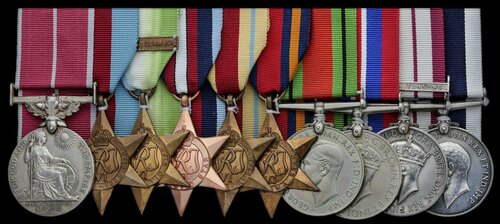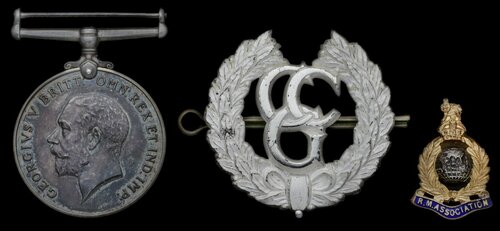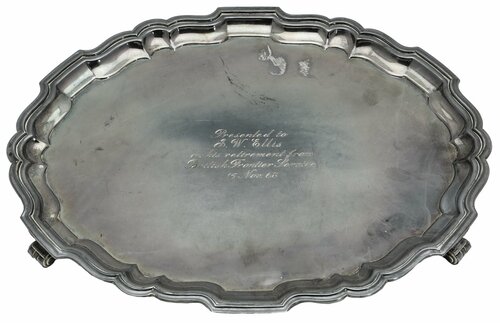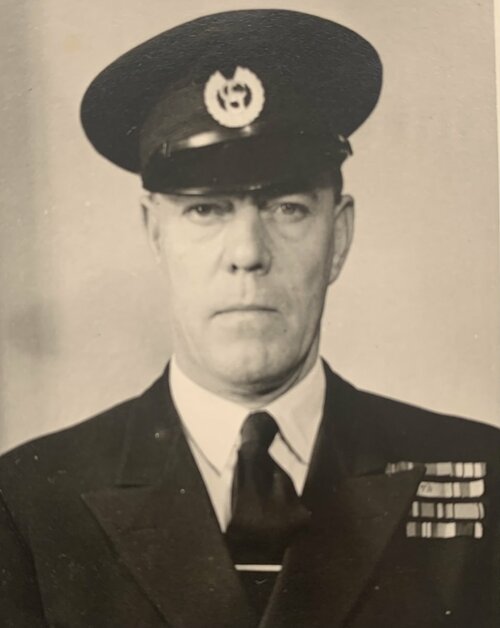Auction: 21003 - Orders, Decorations and Medals
Lot: 475
A 1945 B.E.M. group of eleven awarded to Colour Sergeant J. W. Ellis, Royal Marines, a veteran of the Arctic Convoys PQ2 and QP2 aboard H.M.S. Norfolk - previously present during the famous Bismarck action
British Empire Medal, Military Division, G.VI.R. (Mrne. John W. Ellis. R.M. Ply.21120.), impressed naming on a prepared ground, with card box of issue; 1939-45 Star; Atlantic Star, clasp, France and Germany; Arctic Star, with its box of issue named to 'J W Ellis PLYX/21120'; Africa Star; Burma Star; Defence and War Medals 1939-45; Naval General Service 1915-62, 1 clasp, S. E. Asia 1945-45; Royal Navy L.S. & G.C., G.V.R., Coinage Head bust (Ply. 21120 J. W. Ellis. Sgt. R.M.), this last a double-issue with two Medals identically named, mounted court-style for display, good very fine (11)
B.E.M. London Gazette 1 January 1945.
John Walter Ellis was born on 4 September 1903 at St Andrews, Plymouth and joined the Royal Marines on 24 October 1921. Promoted Sergeant on 1 December 1933, his L.S. & G.C. Medal was issued on 28 February 1937. Ellis served aboard Norfolk during the Second World War from 14 June 1940, that saw her form part of Force K, also being tasked with tracking the Admiral Scheer.
Bismarck action
The moment it became known that the Bismarck and Prinz Eugen had put to sea from Bergen, dispositions were at once made to prevent the enemy from breaking into the Atlantic to execute Admiral Lutjens’s ‘Good hunting and good bag.’
Sent to patrol the Denmark Straits, the cruisers H.M.S. Suffolk and H.M.S. Norfolk set out to track down the enemy, poor weather with fog and ice floes making their brief all the more difficult. On the evening of 23 May 1941, however, lookouts aboard the Suffolk, followed by those in the Norfolk, sighted the German ships sailing at high speed on a south-westerly course. Admiral Wake-Walker, with his flag in Norfolk, immediately reported this intelligence to the surrounding British forces.
Throughout the night the two cruisers continued to shadow the enemy force and, on the following morning, witnessed the attack carried out by the Prince of Wales and the Hood, the ultimate result of which was the terrible loss of the latter battleship. Hits, however, were observed on the Bismarck, and soon afterwards a successful torpedo strike was delivered by a Fleet Air Arm aircraft from the Victorious.
On the evening of 25 May contact was lost and it was not until a Coastal Command aircraft re-sighted the Bismarck some 550 miles west of Land’s End that the Royal Navy moved in for the kill, a victory that prompted Churchill to state to the House of Commons on 27 May:
‘Great as is our loss in the Hood, the Bismarck must be regarded as the most powerful as she is newest battleship in the world, and the striking of her from the German Navy is a very definitive simplification of the task of maintaining the effective mastery of the Northern Sea and the maintenance of the Northern Blockade.’
The Norfolk’s role throughout the pursuit of the Bismarck was a significant one and on at least one occasion she came under the Bismarck’s direct fire. The following extract was taken from Pursuit, by Ludovic Kennedy:
“...Norfolk, meanwhile, fifteen miles away inside the fog, had picked up the first of Suffolk’s signals: her Captain Alfred Phillips was in his sea-cabin eating cheese on toast when the Yeoman of Signals burst in with the news. Phillips at once increased speed and steered for the open water, but in his eagerness not to lose touch, he misjudged the direction, and emerged from the fog to find Bismarck only six miles ahead, coming straight at him. This time there was no doubting her readiness. As Norfolk swung to starboard to get back to the safety of the fog, Bismarck’s guns roared in anger for the first time. On the Norfolk’s bridge they saw the ripple of the orange flashes and brown puffs of cordite smoke, heard the scream of the shells - a sound which some have likened to the tearing of linen and others to the approach of an express train. Admiral Wake-Walker saw the sea to starboard pocked with shell splinters, observed one complete burnished shell bounce off the water fifty yards away, ricochet over the bridge. Great columns of milk-white water rose in the air, two hundred feet high. Five salvoes in all Bismarck fired before Norfolk regained the mist: some straddled, and splinters came aboard; but there were no casualties or hits.'
The 8-inch guns of Norfolk, alongside the heavier armaments of the Rodney and King George V, greatly contributed to the final bombardment of the Bismarck and as the Dorsetshire’s torpedoes delivered the coup-de-grâce, so ended one of the greatest threats ever placed upon allied convoys in the North Sea.
Arctic Convoy duties
Ellis also served during the Arctic Convoys on PQ2 (18-30 October 1941) and QP2 (3-11 November 1941). He was removed from the Norfolk and reduced to Marine on 16 February 1942, also being 'deprived of L.S. & G.C. Medal' (Service Record, refers). His service was terminated on 2 October 1942 but he re-enlisted on 26 October 1942, seeing service with the Armed Supply Group and 34th Amphibious Assault Regiment. This latter posting included service in South East Asia in 1945-46. Ellis was finally discharged on 9 June 1947. He latterly saw service with the Controls Commission Germany and retired from the British Frontier Service in November 1968. He died on 12 May 1978.
Sold together with a fine original archive of material comprising:
(i)
Original issuance slip, letters of application and confirmation for the Arctic Star, which was issued on 26 September 1918.
(ii)
His passport, besides two West German passports of other citizens.
(iii)
Two Royal Marines permanent passes, together with other original documentation, Control Commission Germany cap Badge and copied Service Record.
(iv)
Silver-plate salver, engraved 'Presented to J. W. Ellis on his retirement from British Frontier Service 15 Nov. 68.'
Subject to 20% VAT on Buyer’s Premium. For more information please view Terms and Conditions for Buyers.
Sold for
£2,000
Starting price
£480











